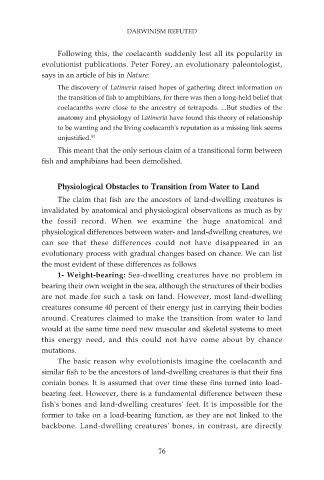Page 78 - Darwinism Refuted
P. 78
DARWINISM REFUTED
Following this, the coelacanth suddenly lost all its popularity in
evolutionist publications. Peter Forey, an evolutionary paleontologist,
says in an article of his in Nature:
The discovery of Latimeria raised hopes of gathering direct information on
the transition of fish to amphibians, for there was then a long-held belief that
coelacanths were close to the ancestry of tetrapods. ...But studies of the
anatomy and physiology of Latimeria have found this theory of relationship
to be wanting and the living coelacanth's reputation as a missing link seems
unjustified. 91
This meant that the only serious claim of a transitional form between
fish and amphibians had been demolished.
Physiological Obstacles to Transition from Water to Land
The claim that fish are the ancestors of land-dwelling creatures is
invalidated by anatomical and physiological observations as much as by
the fossil record. When we examine the huge anatomical and
physiological differences between water- and land-dwelling creatures, we
can see that these differences could not have disappeared in an
evolutionary process with gradual changes based on chance. We can list
the most evident of these differences as follows
1- Weight-bearing: Sea-dwelling creatures have no problem in
bearing their own weight in the sea, although the structures of their bodies
are not made for such a task on land. However, most land-dwelling
creatures consume 40 percent of their energy just in carrying their bodies
around. Creatures claimed to make the transition from water to land
would at the same time need new muscular and skeletal systems to meet
this energy need, and this could not have come about by chance
mutations.
The basic reason why evolutionists imagine the coelacanth and
similar fish to be the ancestors of land-dwelling creatures is that their fins
contain bones. It is assumed that over time these fins turned into load-
bearing feet. However, there is a fundamental difference between these
fish's bones and land-dwelling creatures' feet. It is impossible for the
former to take on a load-bearing function, as they are not linked to the
backbone. Land-dwelling creatures' bones, in contrast, are directly
76

